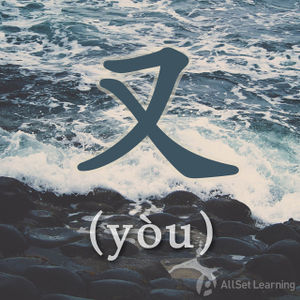Difference between revisions of "Repeated actions in the past with "you""
| Line 32: | Line 32: | ||
{{Basic Grammar|又|B2|Subj. + Verb + 了 + 又 + Verb |他 <strong>找</strong> 了 <em>又</em> <strong>找</strong>,还 是 没 找 到 他 的 钱 包。|grammar point|}} | {{Basic Grammar|又|B2|Subj. + Verb + 了 + 又 + Verb |他 <strong>找</strong> 了 <em>又</em> <strong>找</strong>,还 是 没 找 到 他 的 钱 包。|grammar point|}} | ||
{{Rel char|又}} | {{Rel char|又}} | ||
| − | {{Used for|Describing | + | {{Used for|Describing actions}} |
{{POS|Adverbs}} | {{POS|Adverbs}} | ||
Revision as of 01:45, 28 November 2016
-
Level
-
Similar to
-
Used for
-
Keywords
| This article is a stub. Editors can help the Chinese Grammar Wiki by expanding it. |
Structure
Similarly, we can express extra repetition in the past with another structure with 又. Here we repeat the verb used and place 又 in the middle. The repetition of the verb emphasizes how the action is being repeated again and again. Note that 了 must be placed before the first 又.
Subj. + Verb + 了 + 又 + Verb
Examples
- 宝宝 出生 了 , 妈妈 看 了 又 看 , 高兴 得 不得了 。The baby was born, and the mother just kept looking and looking at it. She was very happy.
- 这 个 词 我 记 了 又 记,还是 记 不住 。I've tried to memorize this word over and over, but I still can't remember it.
- 这 个 方案 改 了 又 改 , 终于 通过 了 。This plan was changed again and again, and finally it passed.
- 我 想 了 又 想 , 还是 不 能 这样 做 。I thought it over again and again, and I still can't do this.
- 他 找 了 又 找,还 是 没 找 到 他 的 钱 包。 He searched again and again, and still couldn't find his wallet.



